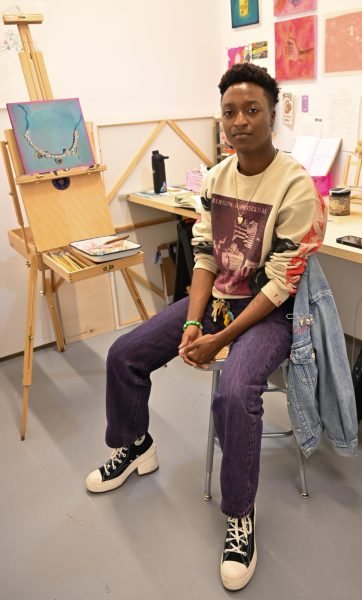For transgender individuals, clothes can be either restrictive or freeing, and this relationship with fashion can change while exploring their identity. From the time people are born, parents often dress their children pink or blue to reflect their child’s sex. As a society, we are programmed into adopting the gendered behaviors associated with that sex from birth. Gender norms can cause so many issues, a fact that holds especially true for trans people.
For CAS senior Cam John, she points to clothes as a tool for social recognition of her identity as a transgender woman.

“[Clothing has] been the thing that’s helped me match and express how I felt on the inside for a while and to signal to others my identity,” John said. “It’s been nice to receive the social recognition of what I know to be true as far as my identity.”
She also mentioned that at the start of her transition, she especially presented her identity through clothing. Through bright colors and hyperfemininity, she was able to feel connected to girlhood in a way she never could when she was younger. Now, John mentioned how she connects with her femininity through makeup, and how it has helped her pass as a woman.
“[Makeup] doesn’t need to be so flashy if you don’t want it to be,” John said. “Although the goal to pass is different for other people, I think if that’s a goal for someone, then subtlety is what works best in my experience.”
While John uses elements of fashion to exemplify her discovered identity, Tisch senior Nikolai’s clothing preferences growing up were an indicator that helped them discover their nonbinary and trans-masculine identity. Nikolai grew up feeling uncomfortable in feminine clothing, which later helped him better understand his relationship to his body.

“I felt very uncomfortable in school when we were forced to wear pencil skirts … most of the girls would try to roll them up, which I never understood, ” Nikolai said. “Maybe I didn’t like showing off my body, because I didn’t like my body the way it was.”
Nikolai’s fashion choices have evolved while discovering more about their own identity.
“Originally, makeup was a tool for me to fit into femininity,” Nikolai said. “I then wanted to take that tool and make it more about art than gender … I started drawing pictures on my face, and making really avant-garde styles, to disidentify from the binary around me.”
Most significantly, after getting top surgery this past May, Nikolai found a new appreciation for femme clothing which formerly made him uncomfortable.
“Right after I got to have surgery, my girlfriend took me on a shopping spree and we bought a ton of femme clothing,” Nikolai said. “I finally wanted to wear all the dresses because I knew how they would look on me. It helped me understand that I actually liked a lot of those clothes –– it’s the way that I was objectified in them that I hated.”
In addition to clothing, transmasculine Steinhardt senior Dyllan Larmond enjoys incorporating traditional LGBTQ+ accessories such as hanky codes — a colored handkerchief worn in the back pocket with the chosen color indicating the individual’s sexual interests and roles — to his everyday outfits.

Larmond highlights the necessity for clothing stores to have more trans-inclusive sizes in both the male and female sections in order to better support the clothing preferences of trans individuals and to give them the space to experiment with their style. He usually finds himself shopping in the women’s section because the male clothing section of many stores don’t have sizes that fit.
“I find I’m too small for a lot of men’s clothing,” he said. “For example, at Levi’s, their smallest waist size on men’s goes down to 28.”
Larmond looks down upon the notion of exclusive fashion and said that in an ideal world, we would do away with catering to such binaries and eradicate separate departments for male and female clothing in stores.
“Gendering fashion is one of the most oppressive parts about visually expressing yourself,” Larmond said. “When you really think about it, it is all just cuts of fabric made to fit bodies.”
Contact Zara Surti at [email protected].























































































































































